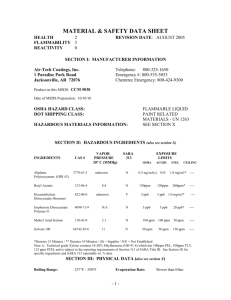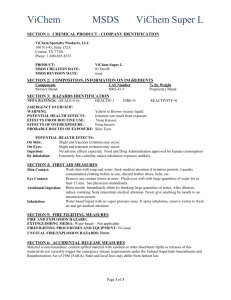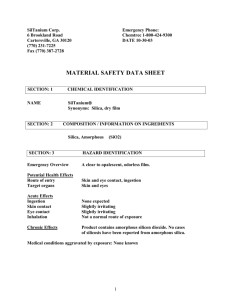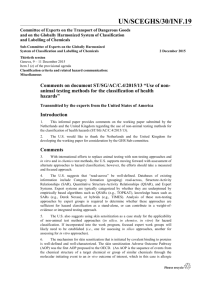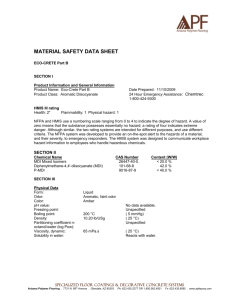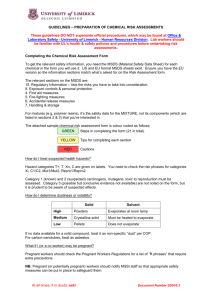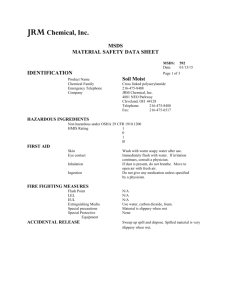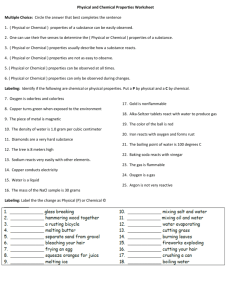Microsoft Word - r3112586.rtf
advertisement
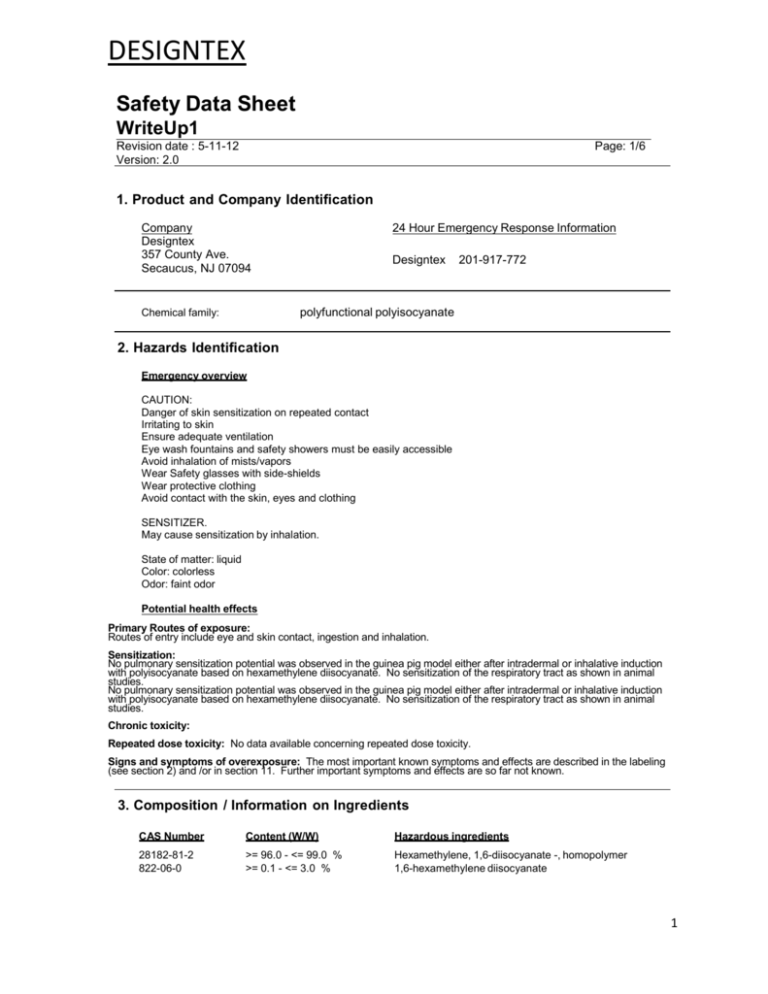
DESIGNTEX Safety Data Sheet WriteUp1 Revision date : 5-11-12 Version: 2.0 Page: 1/6 1. Product and Company Identification Company Designtex 357 County Ave. Secaucus, NJ 07094 24 Hour Emergency Response Information Designtex 201-917-772 polyfunctional polyisocyanate Chemical family: 2. Hazards Identification Emergency overview CAUTION: Danger of skin sensitization on repeated contact Irritating to skin Ensure adequate ventilation Eye wash fountains and safety showers must be easily accessible Avoid inhalation of mists/vapors Wear Safety glasses with side-shields Wear protective clothing Avoid contact with the skin, eyes and clothing SENSITIZER. May cause sensitization by inhalation. State of matter: liquid Color: colorless Odor: faint odor Potential health effects Primary Routes of exposure: Routes of entry include eye and skin contact, ingestion and inhalation. Sensitization: No pulmonary sensitization potential was observed in the guinea pig model either after intradermal or inhalative induction with polyisocyanate based on hexamethylene diisocyanate. No sensitization of the respiratory tract as shown in animal studies. No pulmonary sensitization potential was observed in the guinea pig model either after intradermal or inhalative induction with polyisocyanate based on hexamethylene diisocyanate. No sensitization of the respiratory tract as shown in animal studies. Chronic toxicity: Repeated dose toxicity: No data available concerning repeated dose toxicity. Signs and symptoms of overexposure: The most important known symptoms and effects are described in the labeling (see section 2) and /or in section 11. Further important symptoms and effects are so far not known. 3. Composition / Information on Ingredients CAS Number Content (W/W) Hazardous ingredients 28182-81-2 822-06-0 >= 96.0 - <= 99.0 % >= 0.1 - <= 3.0 % Hexamethylene, 1,6-diisocyanate -, homopolymer 1,6-hexamethylene diisocyanate 1 DESIGNTEX MSDS WriteUp1 4. First-Aid Measures General advice: Immediately remove contaminated clothing. If inhaled: If difficulties occur after vapor/aerosol has been inhaled, remove to fresh air and seek medical attention. If on skin: Wash affected areas thoroughly with soap and water. If irritation develops, seek medical attention. If in eyes: Immediately wash affected eyes for at least 15 minutes under running water with eyelids held open, consult an eye specialist. If swallowed: Rinse mouth immediately and then drink plenty of water, seek medical attention. Note to physician Treatment: Inhale corticosteroid dose aerosol. Treat according to symptoms (decontamination, vital functions), no known specific antidote, administer corticosteroid dose aerosol to prevent pulmonary edema. 5. Fire-Fighting Measures Flash point: Autoignition: > 392 F° (200 °C) > 392 F° (200 °C) (DIN 51758) (DIN 51794) Suitable extinguishing media: dry extinguishing media, foam Hazards during fire-fighting: Evolution of fumes/fog. The substances/groups of substances mentioned can be released in case of fire. Protective equipment for fire-fighting: Wear a self-contained breathing apparatus. Further information: The degree of risk is governed by the burning substance and the fire conditions. Contaminated extinguishing water must be disposed of in accordance with official regulations. 6. Accidental release measures Personal precautions: Use personal protective clothing. Environmental precautions: Contain contaminated water/firefighting water. Do not discharge into drains/surface waters/groundwater. Cleanup: Correctly dispose of recovered product immediately. For small amounts: Pick up with absorbent material (e.g. sand, sawdust, general-purpose binder). For large amounts: Pump off product. 2 DESIGNTEX MSDS WriteUp1 7. Handling and Storage Handling Protection against fire and explosion: Avoid all sources of ignition: heat, sparks, open flame. Storage General advice: Keep container tightly closed and in a cool place. Storage stability: If moisture enters isocyanate containers, CO2 forms and pressure builds up. 8. Exposure Controls and Personal Protection Components with workplace control parameters 1,6-hexamethylene diisocyanate ACGIH TWA value 0.005 ppm ; Personal protective equipment Respiratory protection: Suitable respiratory protection for lower concentrations or short-term effect: Wear a NIOSH-certified (or equivalent) organic vapor respirator. Hand protection: Manufacturer's directions for use should be observed because of great diversity of types., Chemical resistant protective gloves Eye protection: Safety glasses with side-shields. General safety and hygiene measures: Handle in accordance with good industrial hygiene and safety practice. Wearing of closed work clothing is required additionally to the stated personal protection equipment. Avoid inhalation of mists. Contact with eyes and skin must be avoided. Wash soiled clothing immediately. 9. Physical and Chemical Properties Form: Odor: Color: pH value: Melting Point: Boiling Point: Vapor pressure: Density: Relative Density: Viscosity, dynamic: Solubility in water: VOC: liquid faint odor colorless Not Applicable Not Determined Not Determined 0.0001 mbar 68° F ( 20 °C) 1.1 g/cm3 68° F ( 20 °C) (DIN 51757) 1.10 0.7 Pa.s 68° F ( 20 °C) (DIN 53019) Reacts with water to liberate CO2 gas < 50 grams per liter of coating (calculated) 10. Stability and Reactivity Substances to avoid: amines, amine compounds Hazardous reactions: Reacts with alcohols. Reacts with amines. Reacts with substances which contain active hydrogen. Reacts with water, with formation of carbon dioxide. The formation of gaseous decomposition products builds up pressure in tightly closed containers. 3 DESIGNTEX MSDS WriteUp1 Decomposition products: No hazardous decomposition products if stored and handled as prescribed/indicated. Thermal decomposition: No decomposition if used correctly. 11. Toxicological information Acute toxicity Oral: Type of value: LD50 Species: rat Value: > 2,000 mg/kg Irritation / corrosion Skin: Species: rabbit Result: non-irritant Method: OECD Guideline 404 Eye: Species: rabbit Result: non-irritant Method: OECD Guideline 405 Sensitization: Buehler test Species: guinea pig Result: Non-sensitizing. Guinea pig maximization test Result: sensitizing sensitizing effect in animal tests Other Information: The product has not been tested. The statement has been derived from products of a similar structure and composition. 12. Ecological Information Aquatic invertebrates Acute: OECD Guideline 202, part 1 static Daphnia magna/EL50 (48 h): > 100 mg/l Nominal concentration. The product may hydrolyze. The test result may be partially due to degradation products. Microorganisms Toxicity to microorganisms: OECD Guideline 209 activated sludge, domestic/EC20 (180 min): approx. 150 mg/l The inhibition of the degradation activity of activated sludge is not anticipated when introduced to biological treatment plants in appropriate low concentrations. Nominal concentration. Degradability / Persistence Biological / Abiological Degradation Test method: OECD 301B; ISO 9439; 92/69/EEC, C.4-C, activated sludge Method of analysis: CO2 formation relative to the theoretical value Degree of elimination: 20 - 30 % (28 d) 4 DESIGNTEX MSDS WriteUp1 Evaluation: Poorly biodegradable. Other adverse effects: Do not release untreated into natural waters. The local regulations on waste-water treatment must be followed. The product has not been tested. The statements on ecotoxicology have been derived from the properties of the individual components. 13. Disposal considerations Waste disposal of substance: Dispose of in a licensed facility. Do not discharge into waterways or sewer systems without proper authorization. Container disposal: Dispose of in a licensed facility. Recommend crushing, puncturing or other means to prevent unauthorized use of used containers. 14. Transport Information Land transport TDG Not classified as a dangerous good under transport regulations Sea transport IMDG Not classified as a dangerous good under transport regulations Air transport IATA/ICAO Not classified as a dangerous good under transport regulations 15. Regulatory Information Federal Regulations Registration status: Chemical TSCA, US released w/o restriction on quantity TSCA & 5PMN approved OSHA Hazard Category: Hazardous EPCRA 311/312 (Hazard Categories): Acute 5 DESIGNTEX MSDS WriteUp1 16. Other Information HMIS Rating Health Flammability Physical Hazard 0 = Minimal 1 = 1 1 0 Slight 2 = Moderate 3 = Serious 4 = Severe The method of hazard communication for Designtex is comprised of Product Labels and Material Safety Data Sheets. HMIS ratings are provided by Designtex as a customer service. The HMIS system was designed to communicate workplace hazard information to employees who handle hazardous chemicals. The handling of products containing reactive HDI polyisocyanate/prepolymer and/or monomeric HDI requires appropriate protective measures referred to in this MSDS. These products are therefore recommended only for use in industrial or trade (commercial) applications. They are not suitable for use in Do-It-Yourself applications. Contact Person: Telephone: MSDS Number: Version Date: Craig Platt 201-917-7720 511-2012 05-11-12 This information is furnished without warranty, express or implied. This information is believed to be accurate to the best knowledge of Designtex. The information in this MSDS relates only to the specific material designated herein. Designtex assumes no legal responsibility for use of or reliance upon the information in this MSDS. 6

